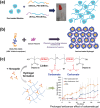Poly Ethylene Glycol (PEG)-Based Hydrogels for Drug Delivery in Cancer Therapy: A Comprehensive Review
- PMID: 37052256
- PMCID: PMC11468892
- DOI: 10.1002/adhm.202300105
Poly Ethylene Glycol (PEG)-Based Hydrogels for Drug Delivery in Cancer Therapy: A Comprehensive Review
Abstract
Hydrogel-based drug delivery systems (DDSs) can leverage therapeutically beneficial outcomes in cancer therapy. In this domain, polyethylene glycol (PEG) has become increasingly popular as a biomedical polymer and has found clinical use. Owing to their excellent biocompatibility, facile modifiability, and high drug encapsulation rate, PEG hydrogels have shown great promise as drug delivery platforms. Here, the progress in emerging novel designs of PEG-hydrogels as DDSs for anti-cancer therapy is reviewed and discussed, focusing on underpinning multiscale release mechanisms categorized under stimuli-responsive and non-responsive drug release. The responsive drug delivery approaches are discussed, and the underpinning release mechanisms are elucidated, covering the systems functioning based on either exogenous stimuli-response, such as photo- and magnetic-sensitive PEG hydrogels, or endogenous stimuli-response, such as enzyme-, pH-, reduction-, and temperature-sensitive PEG hydrogels. Special attention is paid to the commercial potential of PEG-based hydrogels in cancer therapy, highlighting the limitations that need to be addressed in future research for their clinical translation.
Keywords: PEG; cancer; drug delivery system; hydrogels; stimuli-responsiveness.
© 2023 The Authors. Advanced Healthcare Materials published by Wiley-VCH GmbH.
Conflict of interest statement
The authors declare no conflict of interest.
Figures











Similar articles
-
Glyoxylic Hydrazone Linkage-Based PEG Hydrogels for Covalent Entrapment and Controlled Delivery of Doxorubicin.Biomacromolecules. 2019 Jun 10;20(6):2174-2184. doi: 10.1021/acs.biomac.9b00020. Epub 2019 May 7. Biomacromolecules. 2019. PMID: 31021601
-
Protein diffusion characteristics in the hydrogels of poly(ethylene glycol) and zwitterionic poly(sulfobetaine methacrylate) (pSBMA).Acta Biomater. 2016 Aug;40:172-181. doi: 10.1016/j.actbio.2016.04.045. Epub 2016 Apr 30. Acta Biomater. 2016. PMID: 27142255
-
PCL-PEG copolymer based injectable thermosensitive hydrogels.J Control Release. 2022 Mar;343:217-236. doi: 10.1016/j.jconrel.2022.01.035. Epub 2022 Jan 25. J Control Release. 2022. PMID: 35090961 Free PMC article. Review.
-
Polyethylene glycol (PEG)-Poly(N-isopropylacrylamide) (PNIPAAm) based thermosensitive injectable hydrogels for biomedical applications.Eur J Pharm Biopharm. 2014 Nov;88(3):575-85. doi: 10.1016/j.ejpb.2014.07.005. Epub 2014 Aug 1. Eur J Pharm Biopharm. 2014. PMID: 25092423 Review.
-
Photo-cross-linked biodegradable hydrogels based on n-arm-poly(ethylene glycol), poly(ε-caprolactone) and/or methacrylic acid for controlled drug release.J Biomater Appl. 2017 Oct;32(4):511-523. doi: 10.1177/0885328217730465. Epub 2017 Sep 12. J Biomater Appl. 2017. PMID: 28899224
Cited by
-
Vancomycin-Loaded in situ Gelled Hydrogel as an Antibacterial System for Enhancing Repair of Infected Bone Defects.Int J Nanomedicine. 2024 Oct 11;19:10227-10245. doi: 10.2147/IJN.S448876. eCollection 2024. Int J Nanomedicine. 2024. PMID: 39411352 Free PMC article.
-
Female Reproductive Tract Organoids: Applications from Physiology to Pathology.Biomolecules. 2025 Jun 24;15(7):925. doi: 10.3390/biom15070925. Biomolecules. 2025. PMID: 40723797 Free PMC article. Review.
-
Matching placebo development for injectable biologics-a practical tutorial.Antib Ther. 2025 May 8;8(3):177-188. doi: 10.1093/abt/tbaf009. eCollection 2025 Jul. Antib Ther. 2025. PMID: 40583907 Free PMC article.
-
Fabrication and Validation of a 3D Portable PEGDA Microfluidic Chip for Visual Colorimetric Detection of Captured Breast Cancer Cells.Polymers (Basel). 2023 Jul 27;15(15):3183. doi: 10.3390/polym15153183. Polymers (Basel). 2023. PMID: 37571077 Free PMC article.
-
A Comprehensive Review of Radiation-Induced Hydrogels: Synthesis, Properties, and Multidimensional Applications.Gels. 2024 Jun 2;10(6):381. doi: 10.3390/gels10060381. Gels. 2024. PMID: 38920928 Free PMC article. Review.
References
Publication types
MeSH terms
Substances
LinkOut - more resources
Full Text Sources
Medical

